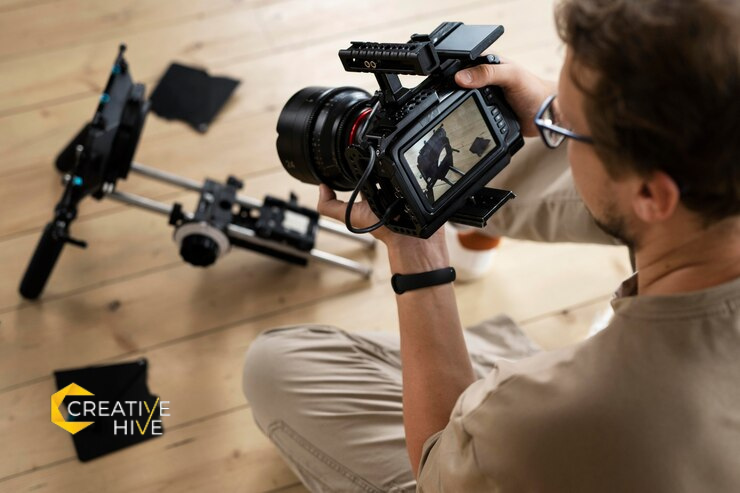In video production, whether you're working on a high-tech industrial project, a straightforward explainer video, or a detailed product showcase, incorporating camera movement can significantly enhance the storytelling aspect of your video. Camera movement does more than just follow the action; it adds a dynamic element that can transform a static scene into a captivating narrative. By skillfully using camera motion, you can create a sense of depth, emphasize key elements, and guide the viewer's attention in a way that static shots simply cannot achieve.
The Power of Camera Movement
The phrase “follow the action” is often used in filmmaking, and for a good reason. By using camera movement to track the action, you create a sense of momentum, inject energy into your scenes, and make the viewer feel like they’re part of the action. Just think about your favorite movie and how camera motion adds depth and excitement to the scenes. Alternatively, consider an interactive play where the audience can move around; the experience is much richer compared to a static, sit-down theater production.
Interestingly, there’s scientific evidence supporting this. Studies on “mirror neurons” suggest that our brains respond to movements we see, almost as if we’re experiencing them ourselves. This concept highlights how dynamic camera movements can engage viewers on a deeper level.
The Director's Perspective
From a director’s standpoint, camera movement is an essential tool for expression. Strategic camera moves can guide the viewer’s attention, maintain engagement, and create a specific atmosphere or mood. The dynamic nature of camera motion infuses the video with aesthetic energy, making it more visually appealing and emotionally compelling.
Options for Camera Movement
For videographers, there are two primary methods to achieve camera movement: handheld and motion-stabilized.
Handheld Camera Movement
Handheld camera work can add a raw, realistic feel to your video, similar to what you might see in indie documentaries. It brings a gritty, immersive quality that can be very effective, although it can be tiring for the audience if used excessively.
Motion-Stabilized Camera Movement
Motion-stabilized camera movement, on the other hand, eliminates the shakes and jitters of handheld shots, creating smooth, weightless footage. This method is preferred for most corporate videos because it looks professional and is easier to watch.
Modern Stabilization Technologies
In the past, adding motion stability was a costly endeavor, requiring equipment like cranes, tracked vehicles, and helicopters with specialized camera rigs. Today, however, advancements in technology have made motion-stabilized equipment more affordable and accessible. Two popular options are servo-driven gimbals and video drones.
Servo-Driven Gimbals
Servo-driven gimbals are a staple in modern video production. They offer flexibility, whether you’re in “run and gun” mode or capturing detailed closeups, pans, and tilts.
- Three-Axis Harness Gimbal: Ideal for all-day shoots, providing full-motion flexibility.
- Compact Hand-Held Gimbal: Small enough to fit in a backpack, perfect for travel and tourism videos.
Favorite Gimbal Moves:
- Leading the subject as they move toward the camera, adding kinetic energy and background interest.
- Following the subject from behind.
- Moving through openings like windows or doors to reveal new spaces.
- Using motion to transition between in-focus and out-of-focus shots.
- Lift shots to uncover scenes hidden behind the foreground.
- Rotating around a focal point to place the subject within their environment.
Video Drones
Video drones have revolutionized the way we capture expansive and awe-inspiring footage. These devices provide stunning aerial views and can navigate tight indoor spaces with ease. Drones can hover in place or move quickly, delivering 4K footage that adds a "wow" factor to any video project.
Favorite Drone Moves:
- Birds-eye views over forests, mountains, villages, beaches, or large indoor areas like factory floors.
- Tracking shots following a worker or vehicle.
- Reveal shots that uncover hidden scenes or objects.
- Slow rotations around a focal point for dramatic effect.
- Vertical rises or falls along subjects of interest, like waterfalls or skyscrapers.
Enhance Your Next Video with Camera Movement
Regardless of your project's nature whether it’s industrial, travel-related, or an explainer video camera movement should be a key component of your shooting strategy. A skilled camera operator will meticulously plan each shot, ensuring that every sequence has a clear beginning, middle, and end. This careful planning results in a cohesive, smoothly flowing video that captivates and engages the audience.
At Creative Hive Studio, we believe that incorporating thoughtful camera movement is essential for producing high-quality, compelling videos. So, on your next video project, remember to move beyond the ‘point and shoot’ approach and explore the dynamic possibilities that camera movement offers.

